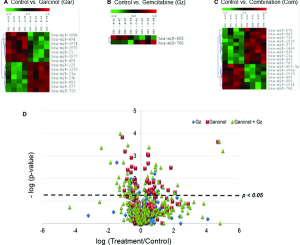Previously, researchers at Wayne State University have showed that garcinol induces pancreatic cancer (PaCa) cell growth arrest and apoptosis in vitro. The present study, discusses chemo-sensitization by garcinol in synergism with first-line PaCa drug, gemcitabine. The miRNA expression profile of gemcitabine-resistant Panc-1 cells treated with garcinol and/or gemcitabine was also evaluated since alterations in microRNA (miRNA/miR) genes are of biological importance in the pathophysiology of cancers, including PaCa. Although growing evidence supports the role of miRNA in cancer, their response to dietary phytochemicals is less known.
Garcinol synergizes with gemcitabine to inhibit cell proliferation and induce apoptosis in PaCa cells with significant modulation of key cancer regulators including PARP, VEGF, MMPs, ILs, caspases, and NF-κB. In addition, biostatistical analyses, quantitative reverse transcription PCR data, and in silico modeling using TargetScan5, PicTar, and DNA intelligent analysis, microT-V.B4 database showed that these two agents modulated a number of microRNAs (miR-21, miR-196a, miR-495, miR-605, miR-638, and miR-453) linked to various canonical oncogenic signaling pathways.
MicroRNA microarrays showed that garcinol and/or gemcitabine treatment alters miRNA profile in PaCa cells. Heat maps (Fig. 3A, B, and C) generated by miRNA microarray analysis revealed expression of several miRNAs that are dysregulated in Panc-1 upon treatment. Figure 3D shows a volcano scatter plot with relative expression of miRNAs in all three treatment groups normalized to that of untreated control cells. A threshold of p < 0.05 (dotted line) was set as a selection criterion. Since garcinol showed a more potent effect in combination with gemcitabine in Panc-1 cells, this cell line was used as a model for further evaluation.
The authors have identified garcinol-specific miRNA biomarkers that sensitize PaCa cells to gemcitabine treatment, thus attenuating the drug-resistance phenotype. These results prompt further interest in garcinol and gemcitabine combination strategy as a drug modality to improve treatment outcome in patients diagnosed with PaCa.
Alteration in miRNA profile on treatment with garcinol alone or in combination with gemcitabine

Panc-1 cells treated with (A) 10 μM garcinol (Gar), (B) 100 nM gemcitabine (Gz), and (C) combination (Com) of above treatments was subjected to microarray analysis. Effect of each of these therapeutic doses on miRNA profile was compared to untreated control cells (p < 0.01). (D) A volcano scatter plot to screen the expression of miRNAs altered between the untreated control to garcinol (red), gemcitabine (Gz; blue), or combination (green) based on fold change and statistical significance. MiRNAs were selected for further investigation based on fold-change on either side of the axis.
Related Service
miRNA Microarray Service – LC Sciences provides a microRNA (miRNA) expression profiling service using microarrays based on our in-house developed µParaflo® technology platform. We have standard arrays for all mature miRNAs of all species available in the latest version of the miRBase database (Release 21, July 2014). Our service is comprehensive and includes sample labeling, array hybridization, image data processing and in-depth data analysis. Two-three weeks after receiving your total RNA samples, we’ll send you both the raw and fully analyzed data. [Learn more…]
Reference
Parasramka MA, Ali S, Banerjee S, Deryavoush T, Sarkar FH, Gupta S. (2013) Garcinol sensitizes human pancreatic adenocarcinoma cells to gemcitabine in association with microRNA signatures. Mol Nutr Food Res 57(2):235-48. [abstract]
